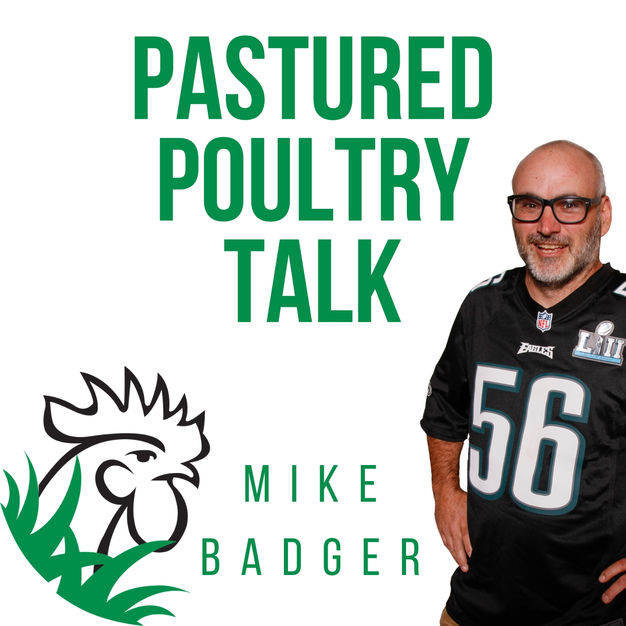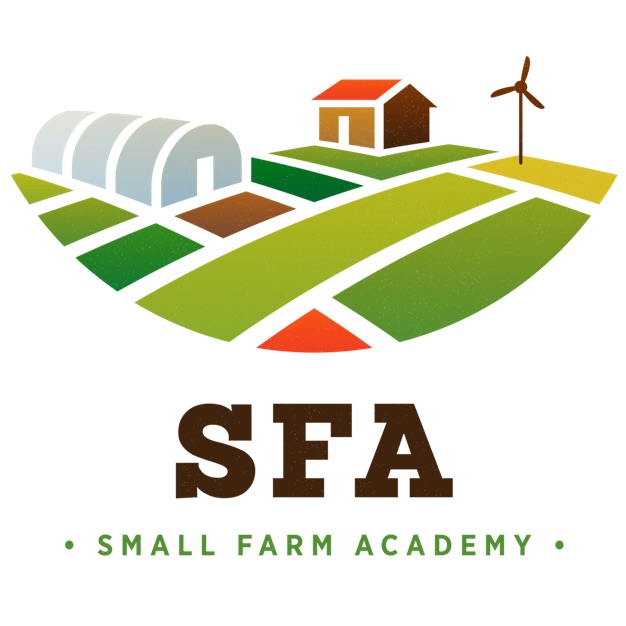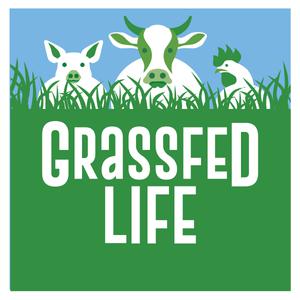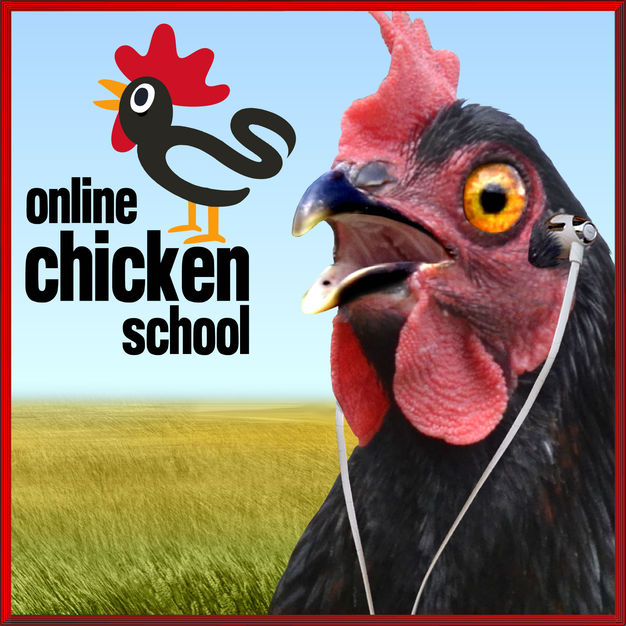
Pastured Poultry Talk
Mike Badger
Mike Badger dives into the the production, the processing, the marketing, and the business of farming pasture-raised poultry. Pastured Poultry Talk is THE podcast where raising chickens, turkeys, and poultry on grass meets real life opportunities, solutions, and farmers. The podcast helps you raise healthy, profitable birds for your family, your community, and your customers.
- 52 minutes 24 secondsHighly Pathogenic Avian Influenza and Pastured Poultry FlocksI have a conversation with Chrislyn Wood, DVM, about the threat of Highly Pathogenic Avian Influenza (HPAI) and pasture raised flocks. Dr. Wood is a veterinarian with USDA APHIS and she is involved first hand with HPAI monitoring and response efforts. We cover a lot of ground, including historical observations, risk assessment, disease identification, and prevention.16 February 2022, 7:45 pm
- 1 hour 1 minuteThe Days of Wholesale Pastured Chickens are Over for Greg Gunthorp
Greg Gunthorp joins the show to talk about his decision to step away from pasture raised chickens. Covid plays into the story, of course, but the challenges started long before this virus came to be front page news.
We also dig into some processing wisdom and reality. Greg talks consolidation and Bill Gates. We dig deep and cover a lot of interconnected ground.
13 March 2021, 12:49 pm - 1 hour 4 minutesTurning a 20 year chicken hobby into a farm with Cynthia Capers
Cynthia Capers, Heniscity Farm in Tennessee, shares her 20+ year journey from hobby chicken keeper to poultry farmer. Twenty years ago, the sight of six Black Australorps brought tears to her eyes. Today, she's serving her community through egg sales, chick sales, pullet sales, and community education. She's incorporated poultry into their rural bed and breakfast and has become an integral resource in her community.
As a black farmer reconnecting to the land and rediscovering her ancestral roots, the journey isn't easy, but Cynthia is right where she needs to be inspiring those around her. She brings the power of chickens to life.
In the show we cover:
- Her exposure to animals in an urban environment
- Incorporating chickens into the B&B
- Covid challenges
- Eggs as the answer to hunger
- Connecting to the land and honoring Mother Africa
- Importance of friends and support
- ...and more
Resources:
Nashville Scene Article: Black Farmers Feed Their Neighbors and Connect With Their Ancestors.
9 February 2021, 3:31 pm - 56 minutes 48 secondsPPT114 - Small Layer Flock Profitability
I answer a listener question, "How can I make my small laying hen flock more profitable?" With feedback from the community, insights from The Fighting Farmer, and personal experience, we dive deep into ways to prosper from your small flock of laying hens.
The answer divides into three sections: management, pricing, and markets/marketing.
Ask your questions at https://pasturedpoultrytalk.com/contact.
28 November 2020, 1:37 pm - 33 minutes 19 secondsPerdue Acquires Pasturebird
Perdue acquires Pasturebird and becomes the biggest producer in the space. I unpack what it means on this episode and walk through some history.
23 October 2020, 2:38 pm - 19 minutes 31 secondsMaintain Production with All In/All Out Rotation for 5,000 laying hens
Listener Chris asks how to utilize an all-in/all-out pullet replacement strategy without duplicating infrastructure while maintaining egg production. To help answer the question, I share insights from Mark Harrison and Dave and Ginger Shields.
The simple answer to the Chris' question is that infrastructure is required to maintain production. Listen in as I discuss the details.
9 October 2020, 6:26 pm - Community Q&A Plus a Monologue on Heritage Poultry's Role in Pastured (PPT109)
I close out the pastured poultry training series with a live streamed Q&A between Terrell Spencer from The Fighting Farmer and myself. We went live on Facebook and fielded questions from our listeners, and this episode of the podcast includes an edited version of that conversation. If you want to watch a replay of the stream, find it on YouTube.
Before we work into the questions, I offer some thoughts on heritage poultry's potential role in pastured community. APPPA has recently started to focus on breeding specific topics and offers monthly livestreams on breeding. Check out APPPA's work here.
We cover a range of topics on this episode including:
- Using a Poultry Man Plucker to improve processing efficiency
- Discussing value-added poultry products and ground chicken
- The number one resource for all new pastured poultry producers
- Spence shares some knowledge on chicken sausage, including a way to sell hearts for $10 a pound
- Canadians are welcome in APPPA
- Spence touches on some USDA processing facility challenges, such as how do you keep the plant full in winter
- Making hay from chickens
- Part of pastured poultry is nutrient management
- What kind of feed should i buy -non-gmo, etc.
- Egg washing equipment
- Mike breaks some soy-free pullet news
- 104: Pastured Poultry Planning and Discovery
- 105: Evaluating Breeds for Pastured Poultry
- 106: 9 Practical Tips for Feeding Pastured Poultry
- 107: Successful Brooder Management for Chicks and Poults
- 108: Perspectives on shelters and pasture management
- 109: Community Q&A Plus a Heritage Poultry Monologue
If you’re looking for fences that work from the people who use them everyday, contact Premier at 800-282-6631 or visit their website to request an informational catalog.
Badger's Millside Farm is a distributor of Ready-to-Lay Pullets. Ask about full beak, non-gmo, certified organic, soy free, and more. Learn more.
28 September 2020, 11:17 am - 11 minutes 58 secondsFeed Management Tips to Reduce Waste & Maintain Egg Production
In Pastured Poultry Talk episode 110, farmer Matt Steinman discussed how he used fermented feed as a solution to feed waste and fines. While fermentation can be a viable solution for some people, it's not the only way to deal with fines.
The problem with fines accumulating in your feeders instead of the birds is that that the chickens miss key nutrients, and they waste feed. The lack of nutrients cause behavioral problems and reduced production. The feed waste costs you money. Soy-free feeds tend to contain more powder and compound the issues with fines.
In this episode I detail a few approaches to dealing with the wasteful fine feed dilemma, which essentially comes down to not adding old feed on top of new feed and avoiding using a bulk feeder. When you use a bulk feeder, you trade convenience for management, and it can compound the problem with feed waste, fines, and overeating (which I don't cover in this episode).
28 September 2020, 11:07 am - 50 minutes 49 secondsIs Fermented Feed Worth the Time for 1,000 hens?
Farmer Matt Steinman (Foothills Farm in Sedro-Woolley, Washington) and Dr. Louisa Brouwer (technical advisor on the trial) share the results of a SARE-funded trial that sought to understand the economic impacts of feeding fermented feed to laying hens. The trial compared a dry feed, wet feed, and a fermented feed and then determined the net difference across to the bottom line.
16 September 2020, 7:17 pm - 1 hour 10 minutesCommunity Q&A PIus a Heritage Poultry Monologue
I close out the pastured poultry training series with a live streamed Q&A between Terrell Spencer from The Fighting Farmer and myself. We went live on Facebook and fielded questions from our listeners, and this episode of the podcast includes an edited version of that conversation. If you want to watch a replay of the stream, find it on YouTube.
Before we work into the questions, I offer some thoughts on heritage poultry's potential role in pastured community. APPPA has recently started to focus on breeding specific topics and offers monthly livestreams on breeding. Check out APPPA's work here.
We cover a range of topics on this episode including:
- Using a Poultry Man Plucker to improve processing efficiency
- Discussing value-added poultry products and ground chicken
- The number one resource for all new pastured poultry producers
- Spence shares some knowledge on chicken sausage, including a way to sell hearts for $10 a pound
- Canadians are welcome in APPPA
- Spence touches on some USDA processing facility challenges, such as how do you keep the plant full in winter
- Making hay from chickens
- Part of pastured poultry is nutrient management
- What kind of feed should i buy -non-gmo, etc.
- Egg washing equipment
- Mike breaks some soy-free pullet news
22 August 2020, 12:56 pm - 1 hour 17 minutesPerspectives on Pastured Poultry Shelters and Pasture Management
When you put chickens or turkeys out on pasture, there are two fundamental questions you need to consider. Why pasture and how do you house the birds?
If you fully grasp the why of the pasture model, you won't take shortcuts in your housing and implementation. I'm primarily talking about the foundational principle of movement to fresh pasture approach that pastured poultry requires. If you choose to build a strong foundation on the principles of pastured poultry, then your system becomes healthier and more capable of surviving challenges.
There are a lot of companies that compromise the pastured poultry model today where fresh forage is replaced with access to more space. I spend a lot of time working through these issues in the podcast episode because it's important to start off with a clear vision, and that vision will inform your shelter approach.
Pasture Shelter ConsiderationsThere are a near infinite number of designs and modifications you can make to a pastured poultry shelter. And if you go shopping for a shelter without having a purpose, you may get sidetracked easily. For example, when I built my first shelter, I just did it like Joel Salatin, but I didn't follow his instructions. That turned out to be a less than ideal shelter for our farm. After I got some experience, I realized I made a bad choice, and I chose something different, which was a smaller, lighter hoop house.
I expect you will go through multiple design iterations, but my goal in the episode to have you make a good choice, so your don't find yourself needing to radically change your approach after a single season.
Here are the pasture shelter and management practices I cover in the podcast episode.
- Provide species appropriate shelters
- Protect from weather (including shade) and predators
- Make flock movement to fresh rooted-in soil vegetation possible
- Avoid static runs and continuous grazing
- Ensure ventilation and protect from drafts
- Add roosts where appropriate
- Add nest boxes for layers
I spend a fair amount of time discussing stocking density guidelines and the nuances you may encounter there. The quick guideline for a daily moved shelter where the birds are confined to a floorless shelter are as follows:
- Broilers: 1.5 to 2 sq. ft. to 8 weeks; 3+ sq. ft. at 16 weeks
- Layers: 3-5 sq. ft.
- Turkeys: 5 to 7 sq. ft.
The reason you need to know stocking densities is so that you can size your shelter appropriately and build/buy the appropriate amount. When you move to a day range setup, the stocking density inside the house becomes different.
Using layers as an example day range scenario, your housing may provide one square foot of space plus your additional pasture space. I discuss the reason behind one square foot in more detail in the episode.
There's no magic formula for the paddock size. 108 square feet is a myth and a fake requirement; it's not synonymous to pasture raised. Just know that if you give your hens 20 square foot of space in the paddock, you will be able to move slightly less frequently than if you only give them 10 square feet of pasture space. The model is based on movement, not access. So, time the frequency of movement to the impact on the pasture. Dirt is not your goal.
Pasture Shelter DesignsI've spent time assembling resources, such as guides, how-tos, and links to pastured poultry coop designs over at American Pastured Poultry Producers Association. View pastured poultry shelter designs.
If you need step-by-step and cut-by-cut instructions, it's hard to beat John Suscovich's Stress Free Chicken Tractor booklet. You can purchase a copy directly from John. If you purchase any of his books or packets, I get a commission (you pay the same price).
Learn more about John's Stress Free Chicken Tractor Plans.
John also appeared on Pastured Poultry Talk to tell his story.
https://pasturedpoultrytalk.com/2015/11/21/ppt029-growing-into-a-farm-with-john-suscovich-2/ Relevant Episodes
https://pasturedpoultrytalk.com/2015/07/17/ppt012-whats-with-the-immaculate-chicken-houses-2/
https://pasturedpoultrytalk.com/2017/09/18/ppt056-designing-movable-shelters-for-pasture-raised-broilers-and-layers-with-pastured-life-farm/
https://pasturedpoultrytalk.com/2016/03/21/ppt037-pastured-poultry-is-more-than-dirt/
https://pasturedpoultrytalk.com/2015/08/28/ppt018-broiler-chicken-shelter-density-and-data-collection-2/
https://pasturedpoultrytalk.com/2019/04/04/latest-greenwashing-craze-pasturewashing-poultry-ppt083/
https://pasturedpoultrytalk.com/2017/12/29/does-the-failed-organic-livestock-and-poultry-practices-regulation-matter-to-pastured-poultry/ Sponsors22 July 2020, 11:45 pm - More Episodes? Get the App
Your feedback is valuable to us. Should you encounter any bugs, glitches, lack of functionality or other problems, please email us on [email protected] or join Moon.FM Telegram Group where you can talk directly to the dev team who are happy to answer any queries.
 smallfarmsustainability's podcast
smallfarmsustainability's podcast
 Small Farm Academy Podcast
Small Farm Academy Podcast
 Green Grass Egg Farming
Green Grass Egg Farming
 Grassfed Life
Grassfed Life
 Online Chicken School Podcast
Online Chicken School Podcast